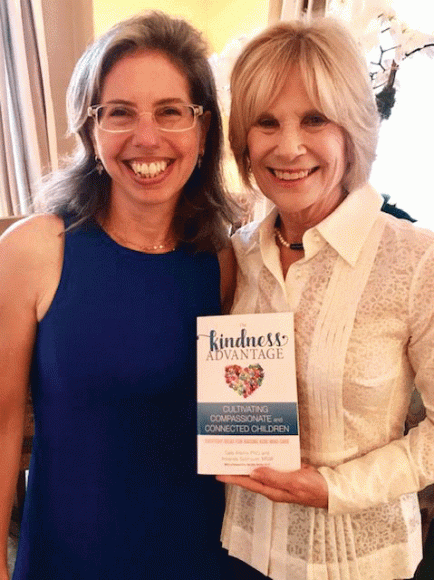Atkins is a psychologist, author and frequent guest expert in the media. She is a mother of two adult sons and grandmother of six grandchildren. Over the last several years, I’ve gotten to know Dale and her husband, Rob, who live in Greenwich. Recently, I talked with her about the book she has co-authored her niece, Amanda Salzhauer, “The Kindness Advantage: Cultivating Compassionate and Connected Children.”
Why did you write a book about kids and kindness?
“Our original plan was to write a book about teaching children how to be charitable and compassionate. It is a topic we had heard others discussing and I had many people ask me about. We also observed kids in our practices and in everyday encounters and were often disappointed to see that many of them were not engaged or connected in the way we know children can be.
“As we began the process, we interviewed people whom we viewed as very charitable and then our focus shifted. We realized that most of the people we interviewed shared several characteristics — acceptance, empathy, commitment and others — that comprise the fundamentals of kindness that we write about. Kindness is the anchor for all of these other attributes.”
How did you decide to collaborate?
“I had the idea for a book about charitable children based on questions and conversations that came up during various talks and media appearances I had done. Ten years ago, after I published “Sanity Savers, Tips for Women to Live a Balanced Life,” the recession of 2007-08 was having its effects. For the next few years, I spoke in the media and to groups in different parts of the country about raising financially responsible and charitable children.
“Amanda Salzhauer, my co-author and niece, has always lived a charitable and connected life. Her three daughters were always encouraged to work in the garden and ‘serve’ in some way, whether in their everyday lives at home, as mentors in their schools or communities or contributing to their friends’ projects. As we spoke further about raising charitable children and the idea for the book, we decided to write it together. Amanda is a social worker and extremely engaged as a leader in her community.”
Why do you include a chapter about offering relaxation tips, techniques and examples in a book about kindness?
“Studies of children who regularly practice relaxation techniques strongly support their effectiveness. These children show a heightened compassion for themselves and others, improved focus, increased resilience and self-esteem, and a sense of inner calm. A simple place to start is with ‘belly breathing.’ Having your child practice focusing on his or her breath is a way to calm him or herself. Dr. Norma Feshbach, former chair of the Department of Early Childhood and Developmental Studies at UCLA, said this regarding the value of relaxation for children:
‘We cannot impart the lessons of kindness when we ourselves are agitated and distressed by the tumult in our lives and in our worlds. Likewise, children have difficulty being kind when they are in the grip of negative emotions. This section provides children and adults with the tools to master negative emotions.’
“Anger, fear, frustration, sadness — any emotion can interfere. This is why we have a section in the book on breathing and relaxation. Kids and parents can benefit from these exercises in their daily life (as well as in higher anxiety situations).”
You talk about people’s brains changing when they help others. Can you discuss the “helper’s high”?
“There is actually a physical response in our body. When we do something kind for someone, think kind thoughts, or even watch someone else do something kind, endorphins (‘feel good’ chemicals) are released in our brain. These endorphins improve our mood resulting in the ‘helper’s high.’ What is really amazing is even when we witness an act of kindness, oxytocin is released. Not only is oxytocin connected to increasing self-esteem and optimism, it can lower blood pressure and improve overall heart health. We benefit when we are kind (or observe kindness).”
Within the context of survival, it’s known that we have an instinct to be sympathetic and caring. Why do we need to work on it?
“Even though we have those instincts, it is important to nurture them. Think of it as a muscle. Although it is part of us, we need to use it to make it stronger. If we don’t use it, it becomes weak or atrophied. Kindness, when practiced, can become a habit. Our kindness muscle can become very strong.”
What should a parent do when his child does not want to sacrifice playtime for helping someone?
“While we want to encourage families to engage in volunteer or service projects, that should be one part of their family life. We do not want them to resent ‘doing good.’ Like a balanced diet of food, kids need a balanced diet of activities. This would include plenty of unstructured playtime, outdoor time, quiet time and volunteer time. That said, no one thing should be sacrificed at the cost of the others.
For more, visit thekindnessadvantagebook.com and reach Giovanni on Twitter @GiovanniRoselli and at his website, GiovanniRoselli.com.


